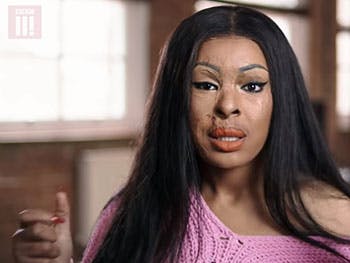EXPERT COMMENT LAST UPDATED : 07 MARCH 2018

PhD researcher and Assistant Lecturer in Criminology, Shona Robinson-Edwards, discusses the Criminal Justice System and the recent BBC documentary on acid attack victim Naomi Oni.
There is an increasing concern about the use of acid, noxious or corrosive fluids as weapons; Naomi Oni’s story has been discussed within the media for some time. Essentially we live in the media; aspects of this case have been documented to some extent by official and unofficial sources.
December 2012 was the year that changed Naomi’s life. Attacked with acid and permanently disfigured, Naomi’s case received media coverage to some extent. This attack was calculated and senseless and conducted by someone who Naomi considered to be a friend.
It was particularly refreshing to watch the recent BBC documentary Acid Attack: My Story. This documentary focused on Naomi’s narrative; after all she was the person who had survived this terrible ordeal.
The documentary has a number of emotive scenes and shows Naomi’s journey - we see her removing and applying makeup, spending time with family and friends and attending hospital appointments. This humanises the case, moving beyond the headlines reported in the newspapers to more of an understanding of Naomi’s experiences.
The government has acknowledged the danger of noxious or corrosive fluids, ‘statistics indicate that noxious or corrosive fluids – including but not limited to acid – were used in London in 454 crimes in 2016, in 261 crimes in 2015 and in 166 crimes in 2014. However, data specifically relating to acid attacks are difficult to find. In October 2017 it was reported that ‘The Home Office does not hold the information requested and does not specifically collect data from police forces on acid and other corrosive attacks as part of its regular data collection. Acid and other corrosive attacks resulting in injury are included in Office for National Statistics published statistics within assault with injury offences and assault with intent to cause serious harm offences, but cannot be disaggregated’.
London’s Metropolitan Police however have provided a breakdown of acid attack data to the BBC. Findings suggest ‘The suspect was male 74% of the time and victim was male 67% of the time’. Acid attacks tend to impact young men; the victims of London’s violent acid attacks are overwhelmingly male; four out of five victims in 2016 were men. Therefore cases of female victims of acid attacks are somewhat uncommon and gain media interest.
In relation to Naomi, initially the local police centred their attention on finding out ‘who’ had carried out this attack, however the investigation quickly moved to ‘if’ this had actually been an attack. Naomi had to deal with false allegations about her character, one being that she may have done this to herself. Naomi was asked if she had been in a gang, there was an assumption that Naomi’s victimhood was tainted or influenced by other elements; she was being questioned and essentially put under interrogation. Naomi’s only hope was to go to the press with her account, however with this came scrutiny and parallels were drawn between Naomi Oni and Katie Piper, another burns survivor.
After press coverage, Naomi’s case then gained the attention of Scotland Yard, but why did it take the intervention of the press to propel a deeper investigation into this case. Was Naomi’s victimhood not as valid as other victims? The concept of an ideal victim needs to be considered. Race, gender, religion, age and class all play a vital part in victim status.
Naomi being a black young woman meant her background was extensively scrutinised. Survivors of these horrific attacks should be recognised for their strength and courage regardless of racial backgrounds, having said this, the case of Katie Piper echoes a very different sentiment to that of Naomi Oni and this needs to be acknowledged. Not all victims are viewed the same. The concerning factor here is that Naomi had to firstly battle through the physical and psychological impacts of being victimised, whilst fighting to justify or prove her victim status. The police investigation and CCTV proved helpful to catch the person guilty of this crime, providing verification of what Naomi had said all along. However if this footage was not available would Naomi’s victim status still be questioned today? This is a question that should be considered.